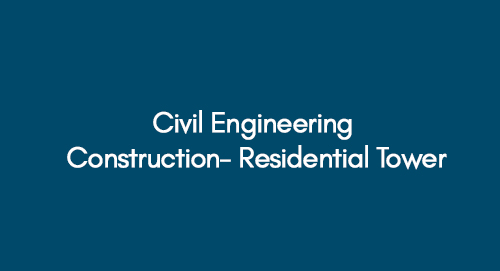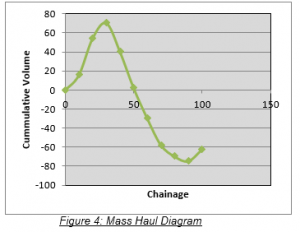
Optical Underwater Wireless Communication
February 27, 2021
Comparison of British and Kazakhstan Legal System
February 27, 2021Chapter No. 1: Introduction
The Design and construction of any building is based upon the concept development, which the prime stage of any project. The design is then completed in accordance with the concept requirements, before the construction of the project is initiated. This project discuss the development and construction of a 20 storey residential tower/building, which is to be constructed in the Ealing Town. The tower is proposed to build having a height of 76 meters, accommodating 127 apartments and/or penthouses. The tower complex is to be constructed with 20 floors, which will provide sufficient space for the individual flats.
The local conditions of the town are favorable for the construction the commercial residence structure building as the site has a history of various successful commercial buildings. The total area of the actual site (with respect to parameters) is 3346 square meters, with the front of 34 meter and depth of 105 meters. The front of the site is towards the Uxbridge Road, and the site borders at rear side with the Craven Road and Craven Avenue. The figure 1 below presents the site and surrounding area;
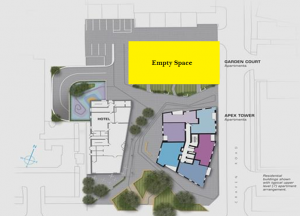
Figure 1: Site Location (edited, lecture notes, 2013)
As shown in the figure above, there is an empty space on the site, which was created through demolition of a building. The site is built-up with various residential blocks. According to the survey conducted of the site, the site is composed of thanet sand, gravels of River Terrace and backfill materials (Assigntment-02, 2013)
Chapter No. 2: Site Layout
The site layout has been prepared considering all the requirements of a multi storey residential building. The building must be provided with all the required facilities and services. Therefore, the spaces have been allocated/specified for the plant rooms and stores etc. Furthermore, the sustainability of the site has been considered, and green open spaces and playing areas have also been provided. Facilities such as gyms and swimming pool are also planned to be accommodated in the final design. The figure/plan below shows the building foot prints of the subject site (next page);
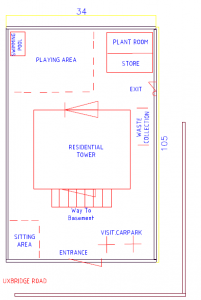
Figure 2: Site Layout (drawn using autoCAD)
As it can be observed from the figure 2 above, the site entrance is at the boulevard frontage. The building is to be constructed in the middle, leaving spaces at the back and at front. The front side is mainly composed of the sitting area and car-parks, and passage to the basement. The underground car park is provided in the basement of the structure, which is given an easy access form the site main entrance.
The back side is to be used for the facilities such as swimming pool and playing area. The building Facilities and Engineering infrastructure has also been provided at the back, which includes a supplies store, plant room and offices.
It is worthwhile to state at this point that the facilities and engineering works must be given much consideration. This is due to the fact that any lack in engineering facilities/works could prove to have an adverse effect on the project. These engineering works include air supply/ventilation system, power supply, and electrical work, piping works, safety and security system
Chapter No. 3: Waste Management
Waste management practices hold a key value in processing, construction or any other industry. Good waste management practice include waste identification, hazard it hazard analyses, collection of waste, waste storage, identifying the waste treatment and disposal methods (Environmental Protection Department, 2013). There are numerous advantages applying an appropriate waste management practices, for example;
- Appropriate waste collection system ensures that any project activity is not interfered/halted
- Waste is removed and processed periodically and efficiently
- Waste is not discharged un-noticed/un-documented
- Materials are utilized with high efficiency
- Environmental and sustainability regulations are dealt with
Therefore, the government has implemented the site waste management plan (SWMPs) for all major construction projects, according to which the SWMPs procedures/policies must be implemented in order to manage the waste generated on site. The procedures o be followed for the project this tower construction project are as below;
- The key areas where the waste is expected to be generated is to be marked
- Expected waste types and respective quantities to be estimated
- Waste storage locations will be identified, separately with respect to waste characteristics
- Appropriate was treatment procedure is to be developed for each waste type. Special consideration will be given to the possibilities of waste recycling and re-use
- Appropriate waste disposal system for each waste type will be developed and implemented on site
The following figure 3 presents the waste management desirability on the site of construction
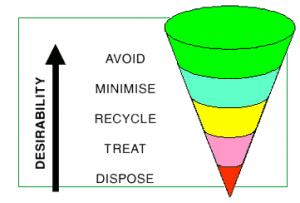
Figure 3: Waste Desirability Policy on Site (source: Environmental Protection Department UK, 2013)
To further analyze the waste management system to be generated, it is important to outline the activities which are able to generate considerable waste on site, which are as below;
- Site preparation
- Demolition of structures on site
- Excavation process, especially during foundation and basement development works
- Import of materials
The wastes generated on site are characterized as;
- Inert Waste
- Active Waste
- Hazardous Waste
The excepted quantities of the waste are given as below;
Table 1: Expected/Estimated Waste Generation on site
Inert Waste | QTY (m3) | Active Waste | QTY (m3) | Hazardous waste | QTY (m3) |
Thanet Sand | 800 | Metals | 55 | Contaminated Soils | 5 |
Gravels | 600 | Packing Materials | 150 | Imported Chemicals | 3 |
Backfill materials | 250 | Papers and Tress | 45 | Liquid toxic/carcinogenic/other | 20 |
Concrete | 200 | Other biodegradables | 150 | ||
Aggregates | 150 | ||||
Blocks and Bricks | 450 | ||||
Excavation | 850 | ||||
Sub-Total | 3,300 | 400 | 28 | ||
Total: 3,728 m3 | |||||
Chapter No. 4: Construction Schedule
The project construction schedule is an activity schedule of the main activities of the construction project. It describes the activities to be undertaken and their respective time in the form of real-time table (Jongeling, 2006). The construction planning of any project is based upon the construction schedule. Therefore, as this stage of the concept development, it is important to prepare the construction schedule of the residential tower project.
The schedule has been prepared based upon the real time, and only the main activities have been considered. The associated time to complete each activity / engineering tasks have been estimated in consultation with the project engineers, forman and project developers. The project schedule presented in this section does not include the planning and design approval stage of the project.
The following table shows the prepared project schedule of the project
Table 2: Project Schedule (Gantt Chart)
Project Major Activities | Months of Year 2014 | Months of Year 2015 | |||||||||||||
2-4 | 4-6 | 6-8 | 9 | 10 | 11 | 12 | 1 | 2 | 3 | 4 | 5 | 6-8 | 8-10 | 10-12 | |
Bill of Quantities and tender approval, procurement team establishment and primary site preparation |
|
|
|
|
|
|
|
|
|
|
|
|
|
|
|
Site Preparation, site perimeter installation, import of machinery and installation of workshops |
|
|
|
|
|
|
|
|
|
|
|
|
|
|
|
Excavation for basement and foundations for all buildings on site | |||||||||||||||
Foundation works for all the buildings and Basement construction | |||||||||||||||
Finishing the foundation and basement works. Import of structure materials and assembling | |||||||||||||||
Construction and/or installation of Structure for all the buildings along with the all the required engineering works | |||||||||||||||
Finishing of the structural works and other engineering works, load testing, flooring, walling and roofing | |||||||||||||||
Chapter No. 5: Earthwork Calculations and Mass Haul Diagram
A new road of approximately 100 meters is to be constructed along the front of the residential tower. Earthwork calculations have been performed to aid in the planning and construction of the road. These calculations and the results obtained would also prove to be useful for the future development of the road. The calculated (given) shrinkage factor is 0.8 (Lecture Notes, 2013). The shrinkage factor is the ratio of the volume after compaction and the volume before compaction. It is also knows the compaction of soil at the finished level.
The table below shows the results of the calculations completed. The cut volumes are given in +ive and the fill volumes in –ive. The shrinkage factor has only been considered for positive volumes. The equivalent volume is calculated as the product of the shrinkage factor and cut/fill volumes.
Table 3: Earthworks Calculations
Chainage (m) | Volume (m3) | Cut (+ive) | Fill (-ive) | Shrinkage factor | Equivalent volume | Cumulative volume |
0-10 | 20.0 | 20.0 | 0.80 | 16.00 | 16 | |
10-20 | 48.0 | 48.0 | 0.80 | 38.40 | 54.4 | |
20-30 | 20.0 | 20.0 | 0.80 | 16.00 | 70.4 | |
30-40 | -30.0 | - | 30.0 | 1.00 | -24.00 | 40.4 |
40-50 | -38.0 | - | 38.0 | 1.00 | -30.40 | 2.4 |
50-60 | -32.0 | - | 32.0 | 1.00 | -25.60 | -29.6 |
60-70 | -28.0 | - | 28.0 | 1.00 | -22.40 | -57.6 |
70-80 | -12.0 | - | 12.0 | 1.00 | -9.60 | -69.6 |
80-90 | -5.0 | - | 50 | 1.00 | -4.00 | -74.6 |
90-100 | 15.0 | 15.0 | 0.80 | 12.00 | -62.6 |
The commutative volume, on y-axis, has been plotted against the chainage, x-axis to give the Mass Haul Diagram, which is gen as below;
Chapter No. 6: Investigations and Justification- Construction Techniques
Various aspects of construction techniques have been considered for the construction of the residential tower. This section provides the investigation and justification of the selected construction technique and type for the construction of tower foundation, basement and structure.
Foundation:
There are mainly two types of the foundation, shallow foundations and deep foundations. The shallow foundation is used where the building structure is in direct contact with the ground. The deep foundations are used where the loads are significantly high and there is a need anchor structures against the uplift forces, and provide resistance to overturning and lateral forces. Although the soil type of site, which is rock, solid chalk sand and gravels, is suitable for shallow foundations, the deep foundation will be constructed to provide additional load-carrying support to the structure. Another reason of this selection is the construction of the basement, which means the foundations will be deep in formation
The piling technique used for the construction of the foundation is bored piles. The large diameter bored piles have been reported to be useful technique or the foundation construction of tall and multi storey buildings.
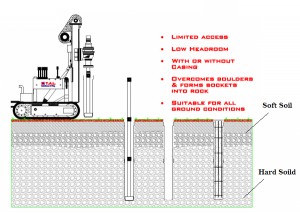
Figure 5: Foundation works (source: edited, TAL Construction, 2013)
As it can be observed from the figure above, large diameter piles are bored using the boring equipment for temporary casting in the form a pile shaft. An extended pile base is constructed at the base of the shaft, at the hard rock soil level. After clearing the pile shaft, installation of permanent liner and reinforced steel cage is completed. In the last stage, the engineered concrete solution is poured in the pile to fill the shaft. These foundations and the steel structure in the piles transform the load of the structure to the foundation base.
Basement:
According to the BS 8102:2009, the basements are characterized in three grades, of which the Grade 3 type has the dry environment with the provision of the ventilation system (BS 8102, 2009). Since, the basement has been planned to be provided under the main residential tower structure, and will be used by all the residents of the tower, the Grade 3 type is proposed to be constructed. Among the sheet piles, secant piles and king post walls, basement support wall for the construction of basement has been selected to be the ‘Diaphragm Walls’. This is due to the fact that the secant piles do not provide the required vertical tolerance and water proofing, where as the diaphragm walls can provide rigid and cost effective permanent retaining walls and respective shafts.
Additionally, the diaphragm walls have less construction joints as compared to other types, and are suitable for the large and open sites where deeper structures are required. This wall type will be constructed by reinforced concrete, which offers high deflection resistance and effective internal propping. These are also more suitable for the deep basements, and will be constructed using the ‘top down’ methods of construction. The figure below shows the basement construction technique of the top down construction method;

Figure 6: Top down construction (source: edited, Construction Project Management Portal, 2013)
The used method is best utilized for urban structures, tall buildings, the deep basements and importantly for underground car park structures. The use o this method can save considerable cost and time, which are the primary factors in this major project (Construction Project Management Portal, 2013). The construction is initiated with the installation of retaining walls, and the basement columns of steel will be constructed before the process excavation begins. Upon completion of the diaphragm walls, the floor slabs and beams are casted to provide lateral support to the walls. The lower stages are then excavated through the openings, and the same procedure is repeated until the basement at the desire level is achieved.
Structural Frames:
There are three mostly used constructions materials for the multi storey buildings, namely masonry, steel and concrete. In, UK, most multi storey buildings use steel as the material of construction for the building structural frame. This is because steel provide optimum structural strength and has lower cost as compared to other materials, which are the two prime design project requirements. The steel further is very useful for the construction of the tower due its excellent adaptability characteristics.
Therefore Steel has been selected for the construction of the residential tower. The steel is completely recyclable in UK. Steel can be erected at higher speed and is readily available in the market. The skilled labor for the installation of steel frames is also readily available and the steel can offer extensive range of the standard beam and column size. All these factor have contributed for the selection of steel as the material of construction for the project

Figure 5: Steel Frames (source: Altair Engineering, 2013)
Chapter No.7: Environmental constraints and Mitigation measures
Protecting the environment and the local habitats is absolutely essential, and required by the lay, therefore every effort will made to ensure that mitigation and environmental protection measures are placed/implemented on the site. The waste management policy of the site would ensure that the waste such as metals, plastics, tarrmac, concrete, bricks and blocks, timber, sub-soils are re-used on site or sent off-site for recycling. Similarly, for construction works, the same waste types will be re-cycled off-site. This practice would reduce the adverse effect on the environment.
The mitigation measures are to be taken to control the natural habitat (Management Strategy for Construction Waste, 2013). Any possibility of an adverse effect on the habitat must be eliminated and therefore the following measures will be taken on site during the construction process;
- Noise pollution will be controlled through effective on-site vehicle and machinery control system; in which the workers and contractors will be educated with respect to the practices to be followed and ecological constraints, which would ensure that noise level is kept to lowest. Furthermore, the advanced machinery will be used on site to assure that any moving parts of the mechanical system do not generate noise pollution
- Air pollution will be controlled through the use of strict on-site transport and machinery management system. The system would insure that limited vehicles are provided access to the site, and all machinery used for the construction do not emit excessive amount of oxides of carbon in the air. Furthermore, any processing requirements specially exothermic reactions such as burning on site will be in accordance with the EPD department
- Liquid waste release in the form of diluted/concentrated chemicals directly to environment can have devastating effect on the local habitat, as this can pollute the surrounding water reservoirs. Any use toxic chemicals on site will be documented and the associated hazard will be analyzed. The use of chemicals and the waste generated though it will be chemically treated and neutralized on site if possible, and if not this will be sent for offsite treatment. No liquid toxic/carcinogenic waste will be discharged on site without approval from the project manager. The process of washing on site and engineered fluid preparation will be in accordance with the approved procedures
The mitigation measures as described above would effectively enhance the environmental performance. The figure below summarizes the objective of the mitigation measures taken
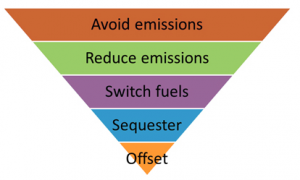
Figure 6: Mitigation Measures (source: ACT Government Operations, 2013)
Chapter No.8: Evaluation and Reflection
The concept development and construction techniques of a multi storey residential tower have been developed in this report. The layout plan of the site was produced which involved architectural design concepts and the location proposals for the placement of the various facilities. The facilities were provided such as to provide ease to the residents of tower. The environmental and sustainability factors were considered, and management practices along with the mitigation measures to be taken were proposed. Research was completed to analyze the construction techniques and to complete the earth wok calculations. Furthermore, an estimated project schedule was also developed which included all the major activities to be undertaken in this construction project.
As much research and design analyses were required to be completed in these tasks, detailed literature was reviewed to develop complete understanding of each project requirement. Research analyses, literature review, methodology selection, calculations and drafting skills were the major learning from the project report.
References
ACT Government Operations, 2013. Available online at: http://www.environment.act.gov.au/climate_change/actgov_ops [Retrieved 07 December 2013]
Architectural Design, 2013. Dorobanti Tower, Romania by Zaha Hadid . Available online at: http://flavahome.com [Retrieved on 09 December 2013].
Altair Engineering, 2013. Overview Advantages of Steel Disadvantages of Steel Related Materials. Available online at: http://altairenlighten.com [Retrieved on 08 December 2013].
Ballard, G., 1997. Look ahead planning: the missing link in production control. Proc.5th Conf. of Lean Construction, pp. 13-25
BS 8102: 2009. Code of practice for protection of below ground structures against water from the ground. Available online at: http://shop.bsigroup.com/ProductDetail/?pid=000000000030168198. [Retrieved 09 December 2013]
Building Sustainable Communities, 2013. Available online at: http://blog.recipro-uk.com [Retrieved on 06 December 2013]
Construction Project Management Portal, 2013. Top-Down Construction Method. Available online at: http://consproman.wordpress.com/2012/04/23/top-down-construction-method/ [Retrieved on 09 December 2013]
Cochran, M. and Honeck, W. C. 2004. Design of Special Concentric Braced Frames. Structural Steel Educational Council, Moraga.
Environmental Protection Department, 2013 - Construction Waste objectives for construction waste management. Available online at: www.epd.gov.hk [Retrieved on 08 December 2013]
International standardization organization, 2006. Environmental Management, Life cycle assessment, Principles and framework.
Jongeling, R. 2006. A Process Model for Work-Flow Management in Construction, Department of Civil and Environmental Engineering, Lulea University of Technology
Mendes Jr., R. and Lopez, O. C., 1998. An expert system for multi-story building scheduling. New Information Technologies for Decision Making in Civil Engineering
Management Strategy for Construction Waste, 2013. Available online at: http://www.epd.gov.hk/epd/misc/cdm/management_intro.htm [Retrieved 08 December 2013]
Lecture Notes, 2013. Semester 1, Civil Engineering Construction, University of West London pp.1-84
TAL Construction, 2013. The Piling & Subsidence Specialists Available online at: http://www.talconstruction.ie/piling [Retrieved 10 December 2013]
Top Down Construction, 2013. Services | Case Foundation Company. Available online at: www.casefoundation.com [Retrieved on 06 December 2013]
Turington, R., van Kempen, R., Wassenberg, E., 2004. High rise housing in Europe: current trends and future prospects”, journal of Housing and Urban Policy Studies 28, pp, 31-48.
Get 3+ Free Dissertation Topics within 24 hours?

















